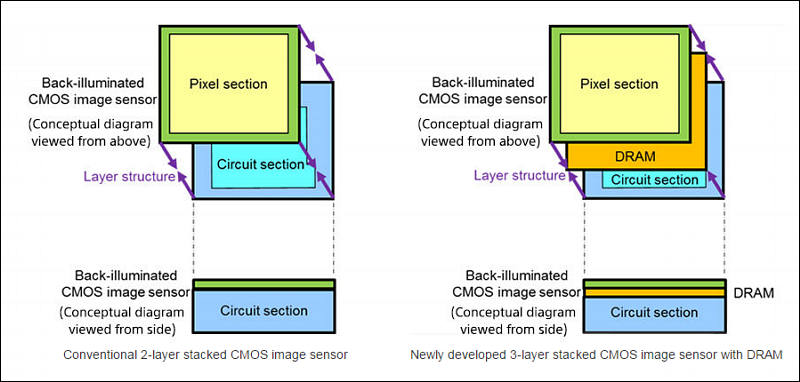
-
This newly developed sensor with DRAM delivers fast data readout speeds, making it possible to capture still images of fast-moving subjects with minimal focal plane distortion as well as super slow motion movies at up to 1,000 frames per second (approximately 8x faster than conventional products in full HD (1920x1080 pixels).

The high-speed readout capability makes it possible to record up to 1,000 fps (approximately 8x faster than conventional products*3) super slow motion movies in full HD (1920x1080 pixels). Normal speed shooting data and maximum 1,000 fps high-speed shooting data stored on the DRAM are exported from the image sensor for signal processing on an external image signal processor (hereafter referred to as ISP), making it possible to record vibrant movies on a smartphone that seamlessly combine normal speed movies and super slow motion movies. To ensure that users don't miss split-second moments in super slow motion movies, it is possible to adjust settings so that sudden subject movement is automatically detected and high-speed shooting begins. Because high-speed shooting data is stored on the DRAM and output at a normal speed, a conventional ISP can be used
http://www.sony.net/SonyInfo/News/Press/201702/17-013E/index.html
-
Resulting in imperceptible jello for most practical purposes?
-
Resulting in imperceptible jello for most practical purposes?
What you mean?
Increase of readout speed for sensor results in much less rolling shutter artifacts.
-
Increase of readout speed for sensor results in much less rolling shutter artifacts.
That's what I was asking thanks!
I wonder if this gets around some of the cooling issues of global shutters. Although I don't understand the specifics I thought current global shutter implementations generate a lot of heat?
-
I wonder if this gets around some of the cooling issues of global shutters. Although I don't understand the specifics I thought current global shutter implementations generate a lot of heat?
Global shutter requires additional elements in each pixel. And such elements add some noise (including heat noise) they also can lead to reduction of sensitivity (as they take space).
With stacked sensor all of electronics also adds heat, but it is located much further from sensor.
Such stacked design is very good for smartphone design as all logic and buffer are very compact and on sensor.
-
Tiny aperture + very fast shutter = need excellent lighting... Realistically mostly outdoor daytime use. My RX100m4 @ 960fps has very noisy images indoors, as expected. Lots of fun though.
-
Tiny aperture + very fast shutter = need excellent lighting... Realistically mostly outdoor daytime use. My RX100m4 @ 960fps has very noisy images indoors, as expected. Lots of fun though.
Well, if you mean pure math aperture, it is not tiny, as it'll be used for premium phones with F1.5-F2 apertures.
But, of course, it'll require good light. Still it is positive thing to see 1080p at 1000fps on phones. They even have some use for measurements, maybe we'll get one for our lab.
-
Covering that Sony announcement, SemiAccurate had this comment:
"Given that the first stacked image sensor for 35mm cameras rolled out in 2015 after Sony announced its development in 2012; we’ve probably got a few more years before this kind of fast sensor readout technology makes its way into DSLR styled cameras. But it seems clear that Sony wants to push its new sensors into phones as quickly as possible and given the competitiveness of that market I have no doubt that we’ll see products equipped with something similar to this stack in the next year."
http://semiaccurate.com/2017/02/09/sony-stacks-memory-sensors-fight-rolling-shutter/
-
We can see new generation already this year in 1" sensors, may be APS-C later in year.
-
First smartphone to use it is Xperia XZ Premium


 sample819.jpg734 x 576 - 30K
sample819.jpg734 x 576 - 30K
Howdy, Stranger!
It looks like you're new here. If you want to get involved, click one of these buttons!
Categories
- Topics List23,992
- Blog5,725
- General and News1,354
- Hacks and Patches1,153
- ↳ Top Settings33
- ↳ Beginners256
- ↳ Archives402
- ↳ Hacks News and Development56
- Cameras2,367
- ↳ Panasonic995
- ↳ Canon118
- ↳ Sony156
- ↳ Nikon96
- ↳ Pentax and Samsung70
- ↳ Olympus and Fujifilm101
- ↳ Compacts and Camcorders300
- ↳ Smartphones for video97
- ↳ Pro Video Cameras191
- ↳ BlackMagic and other raw cameras116
- Skill1,960
- ↳ Business and distribution66
- ↳ Preparation, scripts and legal38
- ↳ Art149
- ↳ Import, Convert, Exporting291
- ↳ Editors191
- ↳ Effects and stunts115
- ↳ Color grading197
- ↳ Sound and Music280
- ↳ Lighting96
- ↳ Software and storage tips266
- Gear5,420
- ↳ Filters, Adapters, Matte boxes344
- ↳ Lenses1,582
- ↳ Follow focus and gears93
- ↳ Sound499
- ↳ Lighting gear314
- ↳ Camera movement230
- ↳ Gimbals and copters302
- ↳ Rigs and related stuff273
- ↳ Power solutions83
- ↳ Monitors and viewfinders340
- ↳ Tripods and fluid heads139
- ↳ Storage286
- ↳ Computers and studio gear560
- ↳ VR and 3D248
- Showcase1,859
- Marketplace2,834
- Offtopic1,320






